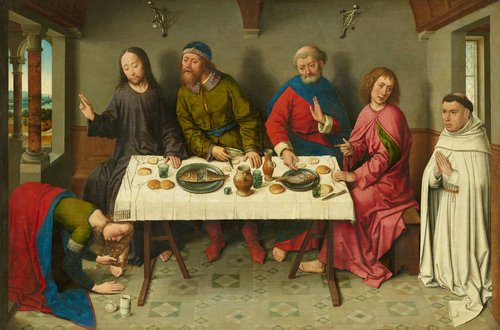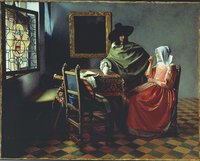The incident narrated by Dierick Bouts in this image is based on the Gospel of Saint Luke (7:36–50). There, we read how the Pharisee Simon invites Christ to dine at his home. Appearing during the meal is a female sinner who is well-known in the town, and who is not named by the evangelist, but is later identified as Mary Magdalen, the sister of Lazarus. To the dismay of his host, she kneels down before Christ and weeps, moistening his feet with her tears, drying them with her hair and anointing them. When the Pharisee sees all of this, he rebukes Christ, saying to himself: “If this man were a prophet, he would know who is touching him and what kind of woman she is – that she is a sinner”. In order to make his behaviour comprehensible, Christ replies to the Pharisee with a simile. He tells the story of a usurer who has two debtors, one of whom owes him 500 groschen, and the other only 50, and both of whose debs he forgives. To Christ’s question: Which of the two debtors should love his creditor the most?, the Pharisee answers that it can only be the one who has been forgiven the larger debt, and has been hence had more bestowed upon him. Christ says to the Pharisee that when he entered his house, the Pharisee neither kissed nor anointed his feet, that the Pharisee had hence not been as generous towards him as the scorned woman at his feet. For this reason, her many sins have been forgiven, for “she has shown great love. But the one to whom little is forgiven, loves little”. And Christ spoke to the sinning woman, saying: “Your faith has saved you; go in peace.” Mary Magdalen is the personality of whom Jacobus de Voragine (1230–98/99) writes in his Legenda aurea: “In the time of grace she did her first penitence. She elected the best part, she sat at the feet of the Lord to hear His word, she anointed His head, she stood near the cross when He died, she prepared the ointment for His corpse, she did not leave the grave when the disciples did leave the grave. She was the one to whom the Lord appeared first when He was resurrected and she was the woman whom the Lord made the Apostle of the Apostles”. The setting for these events is a narrow room with a wooden, barrel vaulted ceiling at whose centre stands a laid table. Two plates with smoked fish, earthenware jugs, glasses, knives and bread have been arranged into an artful still-life. Seated behind the table is Simon, the Pharisee, who leans forward, indignant over the interruption of the meal. His mouth is opened slightly, as though he wishes to articulate his displeasure at the scene that plays itself out before him. Christ, who is the guest of the house, sits to the right of the Pharisee, gazing silently at the kneeling woman, blessing her with his right hand. Astonishment and indignation also characterise the attitude of Peter, who sits to the left of the Pharisee, while John turns towards the kneeling ecclesiastical as though wishing to explain the goings-on to him. This figure is the donor of Bouts’ picture, his white garments identifying him as a member of the Carthusian Order. He kneels devoutly with folded hands next to the table, the gaze of his memorable face directed into an indeterminate distance. Dierick Bouts was a native of Haarlem, and received his initial artistic training in his hometown before migrating to the southern Netherlands. He settled in Leuven around 1445. In 1468, he was entrusted with the honourable office of city painter. His principal masterwork was produced on commission from the municipal authorities and the spiritual fraternity of this celebrated university town. Today, the Sint Pieterskerk in Leuven still preserves this celebrated triptych, centred around the Last Supper, which Bouts executed between 1464 and 1467 on a commission from the Fraternity of the Blessed Sacrament. Occurring somewhat earlier than the execution of this monumental work was the production of the present picture, which itself exemplifies all of the essential traits of Bouts’ art: the loving rendering of an interior, the differentiated illumination, the deep, luminous colours, as well as the silent, seemingly self-absorbed figures. Later, as well, the poignancy and unforgettable simplicity of this picture made a strong impression. Repeatedly, this composition served as a point of departure and model for later versions of this scene – and not just for Aelbrecht Bouts, one of the artist’s sons, but for other masters as well. The fascination that emanates from the works of Dierick Bouts is attributable to his pronounced sensibility for the shaping of space, a capacity that is attributable to his training in the northern Netherlands, and to his extensive preoccupation with the achievement of Petrus Christus and Rogier van der Weyden.| 200 Masterpieces of European Painting – Gemäldegalerie Berlin, 2019
en

